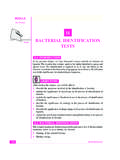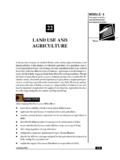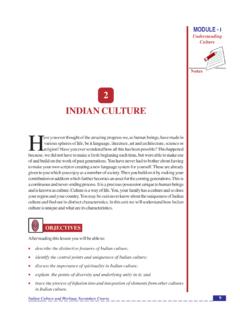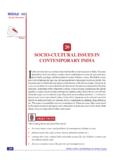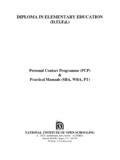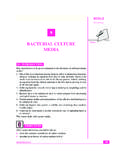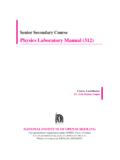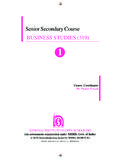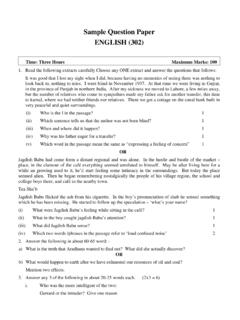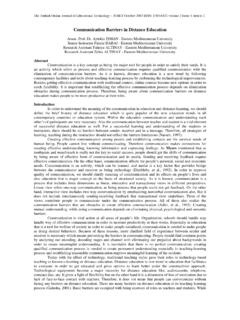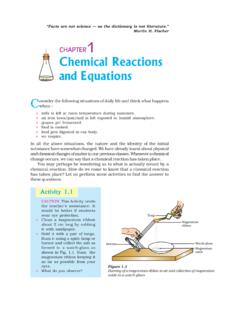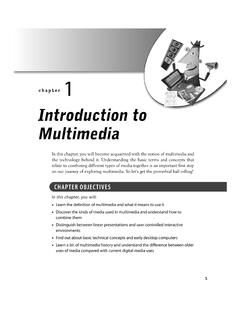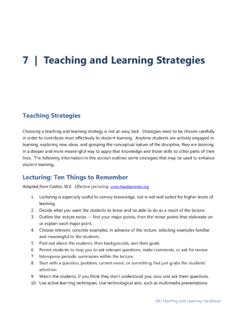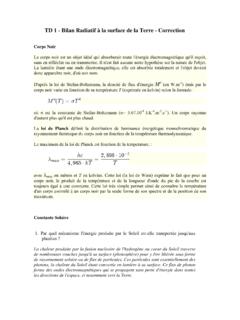Transcription of Notes CHEMICAL REACTION AND EQUATIONS
1 CHEMICAL REACTION and EquationsSCIENCE AND TECHNOLOGY 70 NotesMODULE - 2 Matter in our Surroundings4 CHEMICAL REACTION ANDEQUATIONSE veryday we observe different types of changes in our surroundings. Some of thesechanges are very simple and are of temporary nature. Some others are reallycomplex and of permanent nature. When ice kept in a tumbler is exposed to theatmosphere, it melts and is converted into water. When the tumbler containing thiswater is kept in a freezer it is converted again into ice. Thus, this is a temporarychange and the substance comes to its original form. Such changes are physicalchanges. However, milk once converted into curd can not be converted into milkagain. Such changes are CHEMICAL changes. These changes are of permanent physical and CHEMICAL changes are integral part of our daily life. We can presentthese changes in the form of an this lesson we shall discuss how to write and balance CHEMICAL shallalso describe different types of CHEMICAL completing this lesson, you will be able to: write and balance simple CHEMICAL EQUATIONS ; describe the significance of a balanced CHEMICAL equation; explore the relationship between mole, mass and volume of variousreactants and products; classify CHEMICAL reactions as combination, decomposition, displacementand double displacement reactions and define oxidation and reduction processes (redox reactions ) and correlatethese with corrosion and rancidity and other aspects of daily life.
2 71 CHEMICAL REACTION and EquationsSCIENCE AND TECHNOLOGYN otesMODULE - 2 Matter in our CHEMICAL EQUATIONSYou must have observed many CHEMICAL changes in nature, in your surroundings andin your daily lives. Let us perform a few activities to observe a 2 cm long magnesium ribbon. Clean it with a piece of sand paper. Holdit firmly with a pair of tongs. Heat it over a spirit lamp or a burner until it the ribbon as far as possible from your eyes. What do you observe? Themagnesium ribbon burns with a dazzling light and liberates a lot of heat. It is soonconverted into a white powdery ribbonChina dishWhite powder of MgOPrticles of MgOTongsFig. : Burning of magnesium a few zinc granules in a conical flask or in a test tube. Add dilute sulphuricor hydrochloric acid to it. What do you observe? There is evolution of gas fromthe test tube. If you touch the bottom of the test tube, you will find that it hasbecome quite can perform many more such activities in the laboratory or in the How does one describe these CHEMICAL Changes?
3 The two reactions mentioned above can be written in words as follows : CHEMICAL REACTION and EquationsSCIENCE AND TECHNOLOGY 72 NotesMODULE - 2 Matter in our SurroundingsMagnesium + Oxygen Magnesium (1)reactantsproductZinc + dil Sulphuric acid Zinc sulphate + (2)A substance which undergoes a CHEMICAL change is called the reactant and thesubstance which is formed as a result of a CHEMICAL change is called the REACTION (1) magnesium and oxygen undergo CHEMICAL change and they are thereactants. In REACTION (2) zinc and dilute sulphuric acid are the reactants. Similarlyin REACTION (1) magnesium oxide is a new substance formed. It is the product. Canyou now say what is the product in REACTION (2)? Yes, it is zinc sulphate and CHEMICAL REACTION , the reactant (s) is (are) written on the left hand side and theproduct(s) is (are) written on the right hand side. The change of the reactant intothe product is shown through an arrow. Use of + sign is made when there are morethan one reactant or there are more than one product.
4 Let us see if you can completethe REACTION given below:CalciumChlorineCalcium Writing a CHEMICAL EquationIs there any other shorter way for representing a CHEMICAL change? Yes this can bedone through a CHEMICAL equation. A CHEMICAL equation can be made more conciseand useful if we use CHEMICAL formulae instead of words. In the previous lesson youhave already studied how to represent compound with the help of a CHEMICAL if you substitute formulae of magnesium, oxygen and magnesium oxide for thewords in equation (1), we getMg + O2 (3)Similarly substituting formulae for words in equation B, we get,Zn + H2SO4 ZnSO4 + (4)Do you remember the Law of conservation of mass studied in the previous lesson?According to it, the mass and the number of atoms present in the reactant(s) shouldbe equal to the mass and number of atoms present in product(s). Let us count thenumber of atoms on both sides (left hand side and right hand side) of the chemicalequations (3) and (4).
5 We find that in equation (3), the numbers of oxygen atomson the right hand side and the left hand side are not equal. However in (4), the numberof atoms on both the sides is equal. Such CHEMICAL EQUATIONS in which the numberof atoms is not equal on both sides of the arrow but still represent CHEMICAL reactionsare called skeletal CHEMICAL EQUATIONS . Skeletal CHEMICAL EQUATIONS can bebalanced by using suitable coefficients in the equation. We shall study the balancingof CHEMICAL equation in the following section. 73 CHEMICAL REACTION and EquationsSCIENCE AND TECHNOLOGYN otesMODULE - 2 Matter in our BALANCED CHEMICAL EQUATIONSA ccording to the law of conservation of mass, matter can neither be created nordestroyed. Thus, mass of each element present in the products of a chemicalreaction must be equal to its mass present in the reactants. In other words,the number of atoms of each element remains the same before and after a chemicalreaction.
6 In a balanced CHEMICAL equation number of atoms of a particular elementpresent in the reactants and products must be equal. If not, equation is said to be not balanced. Let us reconsider the above two EQUATIONS (3) and (4). + O2 (3)andZn + H2SO4 ZnSO4 + (4)Which one of the above two is balanced? It is quite obvious that equation (4) isbalanced, as the number of Zn, H and S (sulphur) atoms are equal on both sidesof the equation. Therefore equation (4) is said to be a balanced CHEMICAL what about equation (3)? By simple inspection we can see that the numberof atoms of magnesium in the reactant side is equal to the number of atoms ofmagnesium in the product side. However, the number of atoms of oxygen on thereactant side is two (in O2) but only one atom of oxygen is in the product side in(MgO). To make the same number of atoms of oxygen in the product side, we shallhave to write 2 MgO. Now the equation becomes;Mg + O2 2 MgOIn the above equation there is a shortage of one atom of magnesium on the left handside.
7 For balancing the number of magnesium atoms, we need to put 2 before Mgand the equation becomes,2Mg + O2 2 MgONow the number of magnesium and oxygen atoms is equal on both sides of the arrowand the CHEMICAL equation is said to be balanced. This method of balancing of achemical equation is called the Hit and Trial us consider another REACTION for writing and balancing of a CHEMICAL steam is passed over red hot iron, hydrogen gas (H2) is evolved and magneticoxide of iron (Fe3O4) is obtained. This can be expressed as:Fe + H2O Fe3O4 + H2If we examine the above equation we find that the equation is not balanced. Let ustry to balance it using the following steps: CHEMICAL REACTION and EquationsSCIENCE AND TECHNOLOGY 74 NotesMODULE - 2 Matter in our SurroundingsStep I: Study the equation carefully and write the number of atoms of differentelements in the imbalanced equation:Fe + H2O Fe3O4 + H2 Table Comparing number of atoms of different elementsin reactants and productsElementNumber of atoms onNumber of atoms onreactants side (LHS)products side (RHS)Fe13H22O14 step II: We should start balancing with the compound that contains the maximumnumber of atoms.
8 The compound may be a reactant or a product. In the compound,select the element which has maximum number of atoms. Based on this select Fe3O4in the above equation. In Fe3O4 the element oxygen has the maximum number ofatoms. There are four oxygen atoms on the right hand side and only one oxygenatom on the left hand side of the arrow. For balancing the oxygen atoms, we canput the coefficient 4 as 4H2O . Now the equation becomes:Fe + 4H2O Fe3O4 + H2(partially balanced) step III: Here Fe and H atoms are still not balanced. Let us balance the hydrogenatoms. For this, make the number of molecules of hydrogen as four on the RHSof the arrow. The equation now becomes:Fe + 4H2O Fe3O4 + 4H2(partially balanced) step IV: Now, out of the three elements, only Fe remains imbalanced. For balancingiron, we write 3 atoms of iron on left hand side and the equation becomes:3Fe + 4H2O Fe3O4 + 4H2 step V: Finally count the number of atoms of all the three elements on both sidesof the arrow.
9 You will find that the number of atoms of oxygen, hydrogen and ironon both sides of the arrow are equal and thus the balanced equation is obtained as:3Fe + 4H2O Fe3O4 + 4H2(balanced equation) How can we make a CHEMICAL Equation more Informative?In the balanced equation3Fe + 4H2O Fe3O4 + H2 75 CHEMICAL REACTION and EquationsSCIENCE AND TECHNOLOGYN otesMODULE - 2 Matter in our Surroundingswe have no information about the physical states of the reactants and the whether they are solid, liquid or gas. By using (s) for solids, (l) for liquids and(g) for gases along with reactants and products, we can make a CHEMICAL equationmore informative. Thus, the above equation can be written as:3Fe (s) + 4H2O (g) Fe3O4 (s) + 4H2 (g)..(5)Here, (g) by the side of H2O clearly indicates that water used in the REACTION is inthe form of steam or gas. Further, if a reactant or a product is taken as solution inwater, we denote it by writing (aq). For (s) + H2O (l) Ca(OH)2 (aq).
10 (6)(quick lime)(slacked lime)Sometimes the REACTION conditions such as temperature, pressure, catalyst, etc. forthe REACTION are also indicated above and/or below the arrow in the equation. Forexample,CO (g) + 2H2 (g)340 atm CH3OH (l)..(7)6CO2 (aq) + 6H2O (l)SunlightChlorophyl C6H12O16 (aq) + 6O2 ( g) ..(8)Important Tips for balancing a CHEMICAL equation Use the simplest possible set of whole number coefficients to balance a chemicalequation. Normally we do not write fractional coefficients in such EQUATIONS asmolecules are not available in fractions. We multiply the equation by anappropriate number to ensure the entire equation has whole number coefficients. Do not change subscripts in formulae of reactants or of products during balancing,as that may change the identity of the substances. For example, 2NO2 meanstwo molecules of nitrogen dioxide but if we double the subscript we get N2O4which is the formula of dinitrogen tetroxide, a completely different SIGNIFICANCE OF A BALANCED CHEMICALEQUATIONQ ualitatively a CHEMICAL equation simply describes what the reactants and productsare.
